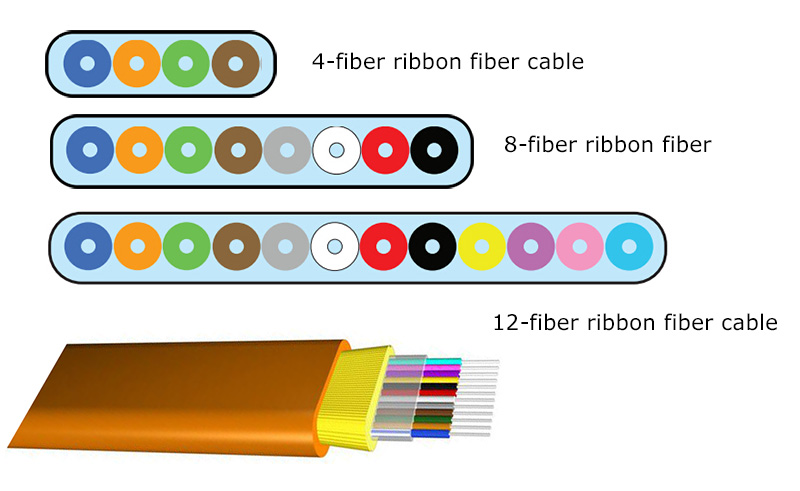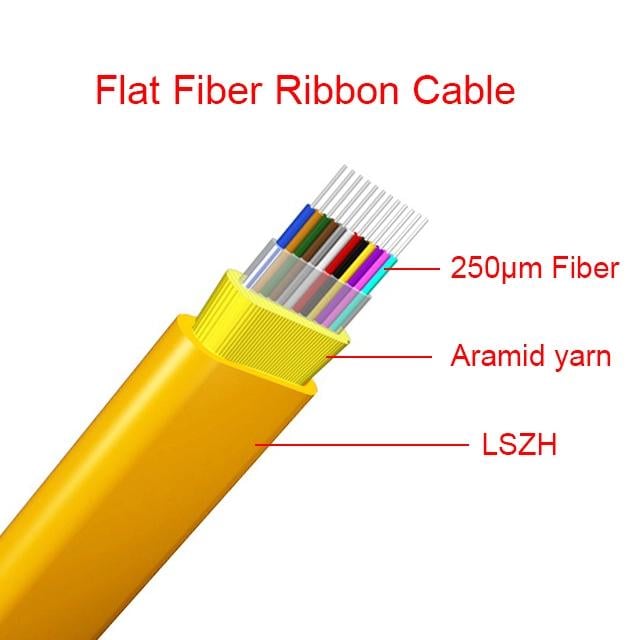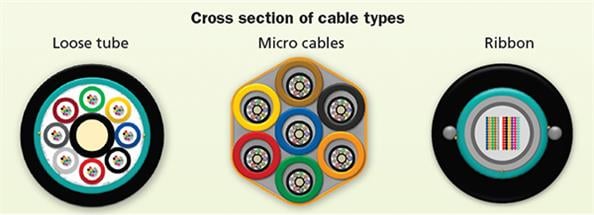Ribbon fiber optic cable, as a key component of modern fiber optic communication technology, is widely used in various network infrastructures due to its high density, high performance, and high reliability. As a leading supplier of fiber optic products, Fibermart understands the importance of choosing the right ribbon fiber optic cable to optimize network performance. We are committed to providing comprehensive solutions to help you make the best choices in a complex and dynamic market. This blog will provide a detailed analysis of different types of ribbon fiber optic cables on the market, introducing their characteristics, advantages and disadvantages, and key selection factors to help you achieve efficient and reliable network construction goals. With our professional guidance, you will be able to better understand the applications of ribbon fiber optic cables and make informed purchasing decisions. Fibermart helps you build a stronger communication network!

Classification of Ribbon Fiber Optic Cables
Classification by Fiber Count
Ribbon fiber optic cables can be classified by fiber count into single-fiber and multi-fiber cables. Single-fiber ribbon optic cables are typically used for low-density communication needs, suitable for small-scale network connections. Multi-fiber ribbon optic cables, on the other hand, are suitable for high-density communication environments, capable of simultaneously transmitting multiple signals, greatly improving data transmission efficiency, and widely used in data centers and large network infrastructures.
Classification by Application Scenario
Based on different application scenarios, ribbon fiber optic cables can be divided into indoor and outdoor cables. Indoor optic cables are usually designed to be more lightweight and are suitable for environments where wiring is simple, such as office buildings and data centers. They typically have higher flexibility, making it easier to lay cables in tight spaces. Outdoor optic cables, however, need to have stronger environmental resistance to cope with various harsh outdoor conditions such as temperature changes, humidity, and mechanical stress. They often adopt more robust protective layers and waterproof designs to ensure reliable performance in adverse conditions.
Classification by Structural Design
The structural design of ribbon fiber optic cables is mainly divided into tight-buffered and loose-tube types. Tight-buffered optic cables have a protective layer directly coated on the fiber, making the overall structure more compact with higher tensile strength, suitable for applications requiring high mechanical strength. Loose-tube optic cables have some space around the fiber, increasing installation flexibility, making them suitable for complex wiring environments, though their tensile strength is relatively lower.

Classification by Fiber Type
According to the type of fiber, ribbon fiber optic cables can be divided into single-mode and multi-mode fibers. Single-mode fibers are suitable for long-distance, high-bandwidth transmission with low signal loss, capable of supporting longer transmission distances and higher transmission rates, commonly used in long-distance communication and core networks. Multi-mode fibers, however, are used for medium to short-distance data transmission, and while they have higher signal loss, they are lower in cost and often used in local area networks (LAN) and within data centers.
Characteristics and Advantages and Disadvantages of Various Types of Ribbon Fiber Optic Cables
Single-Fiber vs. Multi-Fiber Ribbon Fiber Optic Cables
Single-Fiber Ribbon Fiber Optic Cables
Single-fiber ribbon fiber optic cables have a simple structure and are typically used in low-density communication environments. The main advantages include easy installation and high flexibility, making them suitable for rapid deployment in small networks. Additionally, single-fiber optic cables have lower maintenance costs, making them ideal for small-scale wiring projects. However, due to their limited transmission capacity, single-fiber ribbon optic cables are not suitable for high-density data centers or scenarios requiring large-scale data transmission.
Multi-Fiber Ribbon Fiber Optic Cables

Multi-fiber ribbon fiber optic cables are suitable for high-density communication environments, capable of transmitting multiple signals simultaneously, greatly enhancing data transmission efficiency. The main advantage of these cables is their high transmission capacity, supporting large-scale data centers and backbone networks. However, multi-fiber ribbon fiber optic cables are more challenging to install, requiring more specialized equipment and technical support, and their initial installation costs are higher. Nonetheless, their high efficiency and density advantages can bring significant economic benefits in long-term operations.
Indoor vs. Outdoor Ribbon Fiber Optic Cables
Indoor Ribbon Fiber Optic Cables
Indoor ribbon fiber optic cables are designed to be more lightweight and are suitable for simple wiring environments, such as office buildings and data centers. They usually have higher flexibility, making them easier to lay in tight spaces. The main advantages of indoor optic cables are easy installation and high flexibility, without the need for additional protective measures. However, they have poor environmental resistance and cannot withstand harsh outdoor conditions such as extreme temperature changes, humidity, and mechanical stress. Therefore, indoor ribbon fiber optic cables are mainly used in controlled environments.
Outdoor Ribbon Fiber Optic Cables
Outdoor ribbon fiber optic cables have stronger environmental resistance and can cope with various harsh outdoor conditions. These optic cables usually adopt more robust protective layers and waterproof designs to ensure reliable performance in adverse conditions. The main advantages are high durability and reliability, suitable for long-term stable operation in outdoor networks. However, outdoor optic cables are heavier and more challenging to install, with higher initial installation and maintenance costs. Thus, when choosing outdoor ribbon fiber optic cables, it is necessary to fully consider their application environment and specific needs.
Tight-Buffered vs. Loose-Tube Ribbon Fiber Optic Cables
Tight-Buffered Ribbon Fiber Optic Cables
Tight-buffered ribbon fiber optic cables have a protective layer directly coated on the fiber, making the overall structure more compact. The main advantages include high tensile strength, capable of withstanding significant mechanical stress and external pressure, suitable for applications requiring high mechanical strength such as underground ducts and high-load environments. Another advantage is good protection, effectively shielding the fiber from external environmental influences. However, their installation flexibility is lower, requiring higher technical requirements and specialized equipment, and laying cables in tight and complex environments can be more challenging.
Loose-Tube Ribbon Fiber Optic Cables
Loose-tube ribbon fiber optic cables have some space around the fiber, increasing installation flexibility, making them suitable for complex wiring environments. The main advantages are more flexible installation, suitable for various complex wiring environments, and easier adjustment and maintenance of the fiber. Additionally, the loose-tube structure can reduce damage to the fiber during installation, enhancing wiring efficiency. However, their tensile strength is relatively lower, making them unsuitable for high mechanical strength applications, and they are more prone to deformation or damage under external force.

Single-Mode vs. Multi-Mode Fibers
Single-Mode Fibers
Single-mode ribbon fiber optic cables are suitable for long-distance, high-bandwidth transmission with low signal loss, capable of supporting longer transmission distances and higher transmission rates. The main advantages include long transmission distances and high bandwidth, meeting the needs of long-distance communication and core networks. Single-mode fibers are typically used in telecom operators' backbone networks, long-distance transmission lines, and high-bandwidth applications. However, single-mode fibers are more costly, and installation and maintenance require higher technical support, resulting in relatively higher initial investment.
Multi-Mode Fibers
Multi-mode fibers are suitable for medium to short-distance data transmission, with higher signal loss but lower cost, commonly used in local area networks (LAN) and within data centers. The main advantages include high cost-efficiency, suitable for medium to short-distance high-density network connections. The wiring and maintenance of multi-mode fibers are relatively simple, not requiring high-precision equipment and technical support like single-mode fibers. Therefore, multi-mode fibers are widely used in enterprise LANs, internal wiring of data centers, and various medium to short-distance communication networks. However, due to their higher signal loss and limited bandwidth, multi-mode fibers are not suitable for long-distance and ultra-high-bandwidth transmission needs.
Key Factors in Choosing Ribbon Fiber Optic Cables
Application Requirements
When choosing ribbon fiber optic cables, the first factor to consider is the specific application requirements. Different application scenarios have varying requirements for fiber optic cables. Data centers typically require high-density, multi-fiber ribbon fiber optic cables to support large-scale data transmission, while long-distance transmission requires single-mode fibers to ensure transmission distance and bandwidth performance. Understanding and clarifying application requirements is the first step in selecting suitable fiber optic cables.

Cost-Effectiveness
Selecting fiber optic cables requires weighing initial installation costs against long-term maintenance costs. Although single-mode fibers and multi-fiber cables have higher initial costs, their performance advantages in long-distance and high-density transmission can result in higher economic benefits in long-term operations. Loose-tube fiber optic cables, despite lower installation costs, may have higher maintenance difficulties in complex environments, which also needs consideration during selection. Comprehensive assessment of initial investment and long-term operational costs helps in making more cost-effective choices.
Future Scalability
Future scalability is also an important factor when choosing fiber optic cables. As network scales and communication needs grow, selecting fiber optic cables with good scalability can reduce additional costs and workload during future upgrades and expansions. For example, multi-fiber ribbon fiber optic cables, due to their high-density design, can provide more transmission channels in the same space, aiding future network expansion. Considering future demand changes and selecting fiber optic cables with expansion potential is crucial during network planning.
Market Demand for Different Types of Ribbon Fiber Optic Cables
Currently, the ribbon fiber optic cable market is in a rapid development phase, benefiting from the deployment of 5G networks and the rapid expansion of data centers, driving demand for high-density, high-performance fiber optic cables. Particularly, multi-fiber ribbon fiber optic cables, due to their advantages in high-density data transmission, have seen a significant increase in market demand. As global demand for high-speed internet and high-bandwidth applications continues to grow, the market demand for ribbon fiber optic cables is expected to keep rising.
Impact of Emerging Technologies on Ribbon Fiber Optic Cables
With continuous technological advancements, the manufacturing processes and materials of ribbon fiber optic cables are constantly being optimized, resulting in future fiber optic cables with higher transmission performance and stronger environmental adaptability. For example, using new materials and advanced manufacturing processes can further enhance the tensile strength and environmental resistance of fiber optic cables, meeting more diverse application needs. Additionally, advancements in fiber optic communication technologies, such as Wavelength Division Multiplexing (WDM) and Space Division Multiplexing (SDM), will drive wider applications of ribbon fiber optic cables.
Looking for the ribbon fiber optic cable? Check out the best ribbon fiber optic cable at 12 Fibers 9/125μm Single-Mode Multi-Core Indoor Ribbon Flat Fiber Optic Cable-GJFDBV
Conclusion, Choose Fiber-Mart's ribbon fiber optic cables now!
Through the analysis of different types of ribbon fiber optic cables on the market, their characteristics, advantages and disadvantages, selection factors, and market trends, it is evident that ribbon fiber optic cables are key components of modern communication networks, offering high density, high performance, and high reliability. Different types of ribbon fiber optic cables have unique characteristics and performance suited to various application scenarios, and selecting them requires comprehensive consideration of application requirements, cost-effectiveness, and future scalability.
Fiber-Mart offers ribbon fiber optic cables that are widely used in local area networks (LANs), campus and building backbones, and data center backbones. Our products meet the demands of various complex network environments and help you achieve efficient and stable data transmission. Choose Fiber-Mart's ribbon fiber optic cables now to make your network construction easier!
Why choose Fiber-Mart's ribbon fiber optic cables? Our products' high-density design allows for maximum data transmission capacity in limited space; high-performance materials ensure long-term stable operation, even under harsh conditions; and a wide range of types and specifications perfectly match different application scenarios. Whether upgrading an existing network or building a new large data center, our ribbon fiber optic cables are your best choice!
Act now, choose Fiber-Mart's ribbon fiber optic cables, and easily build an efficient, reliable modern communication network. Let your data transmission soar! Fiber-Mart, supporting your every step to success!















No comments have been posted yet.